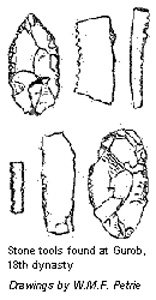Stone has basically three functions for which it is suited: pounding, grinding and cutting. A relatively high specific weight and hardness give it much more impact power than a similarly sized piece of timber would have. This hardness is also what restricts its use as a hammer, because it splinters easily. The stone was either chipped or ground into the desired shape depending on the kind of stone: Fine sandstone, limestone and the like were ground serving as grinding stones and the like, while flint was generally chipped and used for cutting. Some materials like granite could only be worked with spherical hammerstones made of diorite, a stone of even greater hardness. Thanks to their roundness and composition these hammerstones rarely splintered.
 Applied with measured force they were used to slowly pulverize and shape the workpiece. The possibility of creating cutting edges is due to the hardness and crystallinity of the stone. It would be wrong to think that one could just bend down, pick up any stone and make a blade of it. Few kinds of stone are suitable for knapping, the most widely used being flint and chert. Such stone was often found far from the population centres and had to be mined and transported. Desert flint is found in the eastern desert in the form of small cobbles while tabular flint contained as nodules in limestone is quarried: Upper Egyptians got much of their flint from the quarries near Thebes, while Lower Egyptians were possibly supplied from Abu Roash. Opaque flint was preferred by the toolmakers to the clearer varieties.
Applied with measured force they were used to slowly pulverize and shape the workpiece. The possibility of creating cutting edges is due to the hardness and crystallinity of the stone. It would be wrong to think that one could just bend down, pick up any stone and make a blade of it. Few kinds of stone are suitable for knapping, the most widely used being flint and chert. Such stone was often found far from the population centres and had to be mined and transported. Desert flint is found in the eastern desert in the form of small cobbles while tabular flint contained as nodules in limestone is quarried: Upper Egyptians got much of their flint from the quarries near Thebes, while Lower Egyptians were possibly supplied from Abu Roash. Opaque flint was preferred by the toolmakers to the clearer varieties.
It seems the resulting flakes were longer and straighter, their edges tougher and they did not splinter as easily. Because of the flint’s brittleness little pressure should be exerted on thin blades. Stone knives had therefore often no real handle. At one end the blade was left blunt for a few centimetres and wrapped with some fabric and string to give a minimal amount of grip, just enough for cutting, but not enough for breaking the blade. But the knowledge of how to make proper handles and how to fasten them to blades dates back to prehistoric days. The amount of work a knapper invested in making a tool was dependent on the length of time it could be expected to be used. Axes which received harsh treatment and therefore broke quickly were generally fashioned with a few well-placed strokes.
The heads were fastened to the handles by cutting a socket into the wood, inserting the blade and tying it with a cord two or three feet in length. No cement was used. Broken tools were often reshaped and dull edges resharpened. Axe heads were sometimes ground down to such an extent that little stone was left protruding from the socket, before they were discarded. Knapping was quite a difficult craft and became specialised in pre-historic times. Workshops producing stone tools have been found in 4th millennium Hierakonpolis. The advancing bronze age saw a decline in the frequency of use and quality of stone tools, not just because metal displaced stone but possibly also because the best craftsmen preferred the material which offered the more interesting possibilities.
Bronze tools must have been significantly more expensive than flint and therefore less affordable. Knapping, a specialized profession once, probably became one of the tasks which labourers who were not very expert at it but too poor to be able to purchase metal tools, had to perform of necessity. The quality of the stone had deteriorated as well. Deposits closer-by were being exploited despite the poor quality of the flint. But the knowledge of manufacturing basic stone blades continued until Roman times.